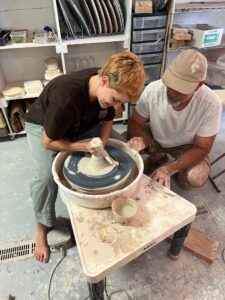How Centering Clay on the Pottery Wheel Can Help Center the Student
Pottery, often regarded as an art form, is not just about creating beautiful vessels—it’s also a journey of self-discovery and personal growth. One of the fundamental techniques in pottery is centering clay on the wheel, and surprisingly, this process goes beyond shaping clay; it can also help center the student, both physically and emotionally. With the guidance of a skilled pottery teacher, individuals can learn how to be centered while centering clay, fostering a sense of inner balance and tranquility.
The Art of Centering Clay: Centering clay on the pottery wheel is a foundational skill in pottery making. It involves applying pressure to a lump of clay while it spins on the wheel, gradually coaxing it into a symmetrical and balanced form. As the clay becomes centered, it becomes easier to shape and manipulate, allowing the potter to create vessels with precision and grace.
Finding Physical Center: The act of centering clay requires focus, patience, and a keen awareness of the body’s movements. As individuals engage in this repetitive and meditative process, they naturally become more attuned to their physical sensations and alignment. By anchoring themselves to the spinning wheel and feeling the resistance of the clay beneath their hands, students develop a sense of grounding and stability in their bodies.
Embracing Emotional Center: Beyond its physical benefits, centering clay can also have profound emotional effects on the student. In the midst of life’s chaos and distractions, the pottery studio becomes a sanctuary—a place where individuals can quiet their minds, release tension, and connect with their inner selves. The rhythmic motion of the wheel and the tactile sensation of clay provide a soothing and therapeutic experience, allowing students to let go of stress and anxiety and find a sense of peace within.
The Role of a Pottery Teacher: A skilled pottery teacher plays a pivotal role in helping students learn how to be centered while centering clay. Through gentle guidance and encouragement, teachers create a supportive environment where students feel empowered to explore their creative potential and innermost thoughts. Teachers offer practical techniques for centering clay, such as proper hand positioning and breathing exercises, while also providing emotional support and encouragement along the way.
Cultivating Mindfulness and Presence: Pottery teachers often emphasize the importance of mindfulness and presence in pottery practice. By encouraging students to focus on the present moment and engage fully in the act of creating, teachers help students develop a greater sense of awareness and mindfulness in their pottery practice and in their daily lives. This mindfulness allows students to let go of distractions and worries, enabling them to fully immerse themselves in the creative process and experience a profound sense of centeredness and calm.
Conclusion: Centering clay on the pottery wheel is not just a technical skill—it’s a transformative practice that can help individuals find inner balance and harmony. With the guidance of a skilled pottery teacher, students can learn how to be centered while centering clay, cultivating a deeper connection to themselves and their craft. So, the next time you step into the pottery studio, remember that the journey of centering clay is also a journey of self-discovery and personal growth.

